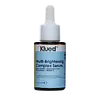What's inside
What's inside
 Key Ingredients
Key Ingredients

 Benefits
Benefits

 Concerns
Concerns

 Ingredients Side-by-side
Ingredients Side-by-side

Water
Skin ConditioningPropylene Glycol
HumectantGlycerin
HumectantPropanediol
SolventPhenoxyethanol
PreservativeButylene Glycol
HumectantPEG-40 Hydrogenated Castor Oil
EmulsifyingHydroxyethylcellulose
Emulsion StabilisingEthylhexylglycerin
Skin ConditioningPolyquaternium-7
Niacinamide
SmoothingAlpha-Arbutin
AntioxidantSodium Metabisulfite
AntioxidantTranexamic Acid
AstringentTocopheryl Acetate
AntioxidantSodium Citrate
BufferingCitric Acid
BufferingAminopropyl Ascorbyl Phosphate
AntioxidantGeranium Robertianum Extract
AstringentPaeonia Suffruticosa Root Extract
Skin ProtectingScutellaria Baicalensis Root Extract
AstringentThymus Serpyllum Extract
Skin ConditioningAlpinia Katsumadai Seed Extract
Skin ConditioningGlutathione
Caprylic/Capric Triglyceride
MaskingHydrogenated Phosphatidylcholine
EmulsifyingPentylene Glycol
Skin ConditioningButyrospermum Parkii Butter
Skin ConditioningSqualane
EmollientCeramide NP
Skin ConditioningWater, Propylene Glycol, Glycerin, Propanediol, Phenoxyethanol, Butylene Glycol, PEG-40 Hydrogenated Castor Oil, Hydroxyethylcellulose, Ethylhexylglycerin, Polyquaternium-7, Niacinamide, Alpha-Arbutin, Sodium Metabisulfite, Tranexamic Acid, Tocopheryl Acetate, Sodium Citrate, Citric Acid, Aminopropyl Ascorbyl Phosphate, Geranium Robertianum Extract, Paeonia Suffruticosa Root Extract, Scutellaria Baicalensis Root Extract, Thymus Serpyllum Extract, Alpinia Katsumadai Seed Extract, Glutathione, Caprylic/Capric Triglyceride, Hydrogenated Phosphatidylcholine, Pentylene Glycol, Butyrospermum Parkii Butter, Squalane, Ceramide NP
Ascorbyl Glucoside
AntioxidantDipotassium Glycyrrhizate
HumectantAscorbic Acid
AntioxidantCitrus Limon Fruit Extract
MaskingHydrolyzed Grape Fruit Extract
HumectantAlpinia Zerumbet Seed Extract
AntimicrobialGlycerin
HumectantButylene Glycol
Humectant1,5-Pentanediol
SolventIsopentyldiol
HumectantGlyceryl Heptanoate
EmollientSorbitan Stearate
EmulsifyingCetearyl Alcohol
EmollientPolyethylene
AbrasiveParaffinum Liquidum
EmollientDimethicone
EmollientPotassium Hydroxide
BufferingPhenoxyethanol
PreservativeBehenyl Alcohol
EmollientSodium Citrate
BufferingAcrylates/C12-22 Alkyl Methacrylate Copolymer
Xanthan Gum
EmulsifyingEDTA
Hydroxyethylcellulose
Emulsion StabilisingCitric Acid
BufferingWater
Skin ConditioningParfum
MaskingAscorbyl Glucoside, Dipotassium Glycyrrhizate, Ascorbic Acid, Citrus Limon Fruit Extract, Hydrolyzed Grape Fruit Extract, Alpinia Zerumbet Seed Extract, Glycerin, Butylene Glycol, 1,5-Pentanediol, Isopentyldiol, Glyceryl Heptanoate, Sorbitan Stearate, Cetearyl Alcohol, Polyethylene, Paraffinum Liquidum, Dimethicone, Potassium Hydroxide, Phenoxyethanol, Behenyl Alcohol, Sodium Citrate, Acrylates/C12-22 Alkyl Methacrylate Copolymer, Xanthan Gum, EDTA, Hydroxyethylcellulose, Citric Acid, Water, Parfum
 Reviews
Reviews

Ingredients Explained
These ingredients are found in both products.
Ingredients higher up in an ingredient list are typically present in a larger amount.
Butylene Glycol (or BG) is used within cosmetic products for a few different reasons:
Overall, Butylene Glycol is a safe and well-rounded ingredient that works well with other ingredients.
Though this ingredient works well with most skin types, some people with sensitive skin may experience a reaction such as allergic rashes, closed comedones, or itchiness.
Learn more about Butylene GlycolCitric Acid is an alpha hydroxy acid (AHA) naturally found in citrus fruits like oranges, lemons, and limes.
Like other AHAs, citric acid can exfoliate skin by breaking down the bonds that hold dead skin cells together. This helps reveal smoother and brighter skin underneath.
However, this exfoliating effect only happens at high concentrations (20%) which can be hard to find in cosmetic products.
Due to this, citric acid is usually included in small amounts as a pH adjuster. This helps keep products slightly more acidic and compatible with skin's natural pH.
In skincare formulas, citric acid can:
While it can provide some skin benefits, research shows lactic acid and glycolic acid are generally more effective and less irritating exfoliants.
Most citric acid used in skincare today is made by fermenting sugars (usually from molasses). This synthetic version is identical to the natural citrus form but easier to stabilize and use in formulations.
Read more about some other popular AHA's here:
Learn more about Citric AcidGlycerin is already naturally found in your skin. It helps moisturize and protect your skin.
A study from 2016 found glycerin to be more effective as a humectant than AHAs and hyaluronic acid.
As a humectant, it helps the skin stay hydrated by pulling moisture to your skin. The low molecular weight of glycerin allows it to pull moisture into the deeper layers of your skin.
Hydrated skin improves your skin barrier; Your skin barrier helps protect against irritants and bacteria.
Glycerin has also been found to have antimicrobial and antiviral properties. Due to these properties, glycerin is often used in wound and burn treatments.
In cosmetics, glycerin is usually derived from plants such as soybean or palm. However, it can also be sourced from animals, such as tallow or animal fat.
This ingredient is organic, colorless, odorless, and non-toxic.
Glycerin is the name for this ingredient in American English. British English uses Glycerol/Glycerine.
Learn more about GlycerinHydroxyethylcellulose is used to improve the texture of products. It is created from a chemical reaction involving ethylene oxide and alkali-cellulose. Cellulose is a sugar found in plant cell walls and help give plants structure.
This ingredient helps stabilize products by preventing ingredients from separating. It can also help thicken the texture of a product.
This ingredient can also be found in pill medicines to help our bodies digest other ingredients.
Learn more about HydroxyethylcellulosePhenoxyethanol is a preservative that has germicide, antimicrobial, and aromatic properties. Studies show that phenoxyethanol can prevent microbial growth. By itself, it has a scent that is similar to that of a rose.
It's often used in formulations along with Caprylyl Glycol to preserve the shelf life of products.
Sodium Citrate is the sodium salts of citric acid. In skincare, it is used to alter pH levels and acts as a preservative.
Its main functions are to maintain the pH of a product and neutralize metal ions.
The acidity of our skin is maintained by our glands and skin biome; normal pH level of skin is slightly acidic (~4.75-5.5).
Being slightly acidic allows our skin to create an "acid mantle". This acid mantle is a thin barrier that protects our skin from bacteria and contaminants.
Learn more about Sodium CitrateWater. It's the most common cosmetic ingredient of all. You'll usually see it at the top of ingredient lists, meaning that it makes up the largest part of the product.
So why is it so popular? Water most often acts as a solvent - this means that it helps dissolve other ingredients into the formulation.
You'll also recognize water as that liquid we all need to stay alive. If you see this, drink a glass of water. Stay hydrated!
Learn more about Water